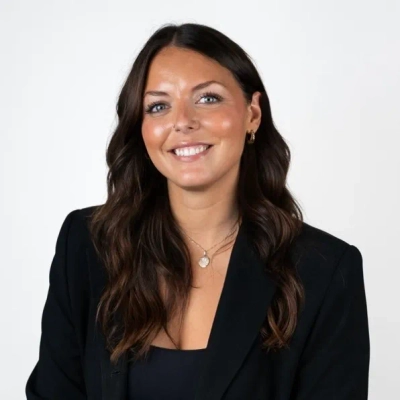13 Ways to Successfully Enter a Saturated Market Against All Odds
Breaking into a saturated market might seem impossible, but industry experts reveal that strategic approaches can turn overwhelming competition into opportunity. This article compiles proven tactics from professionals who have successfully carved out space in crowded industries, from precision targeting in fintech to building trust through radical transparency. These 13 strategies demonstrate that the right positioning and execution can overcome even the steepest market entry barriers.
Care Deeply and Lead Instead of Compete
"Saturated markets don't reject innovation they reject indifference. The moment you care more deeply than anyone else, you stop competing and start leading."
When we worked with a client entering an already crowded market, the first thing we challenged was the assumption that "saturation" meant "no space left." We focused on identifying not the biggest gap, but the most emotionally neglected one the pain point every competitor was too busy to fix. Instead of competing on features or price, we built a brand narrative and user experience around trust, speed, and measurable outcomes. We used data to refine micro-audiences and doubled down on personalization, which made the product feel tailored, not templated. Within six months, that client wasn't just surviving; they were setting the new standard others started to follow. Sometimes disruption isn't about doing something new it's about doing what already exists, but with more empathy and precision.
Precision Targeting Defeats Scale in Fintech
I've often worked with founders facing what felt like impossible odds, and one instance that stands out involved a client trying to enter a saturated fintech market in Europe. Conventional wisdom suggested that their offering, a niche payments platform, would struggle against incumbents with established networks and brand recognition. Most advisors recommended incremental features or waiting for a gap to appear, but we approached it differently at spectup. I remember sitting with the founding team and challenging the assumption that market share could only be won through scale; instead, we focused on precision targeting and messaging tailored to micro-segments that were underserved and overlooked by larger players.
Our key differentiator was reframing the value proposition to highlight hyper-specific pain points rather than broad benefits. We mapped out investor-ready narratives and marketing campaigns that spoke directly to a subset of businesses frustrated with legacy systems. One of our team members helped build a structured outreach program combining personal engagement with data-backed insights, ensuring every interaction felt consultative rather than transactional. I recall the first few weeks of this approach when adoption rates exceeded expectations, not because we outspent competitors, but because we out-understood them.
Another element was leveraging credibility strategically. We positioned the founders as domain experts through LinkedIn content, thought leadership, and participation in niche industry forums. This built trust quickly in pockets that mattered, creating initial traction that eventually snowballed. In parallel, we refined investor communications to highlight how our micro-market strategy could scale, which helped secure follow-on funding to accelerate growth. The broader lesson for founders is that market saturation is rarely a death sentence; it's an invitation to think differently about positioning, audience, and narrative. At spectup, we've found that success often comes from blending strategic insight, disciplined execution, and creative problem-solving, rather than following conventional wisdom. Ultimately, it's not about competing everywhere, but competing where you can win meaningfully.

Speed Becomes the Premium Competitive Advantage
A flooring company wanted to compete in a market dominated by big-box stores, so we positioned them as "the 48-hour install specialists" instead of competing on price or selection. They restructured operations entirely around speed, guaranteeing installation within two days while competitors took 2-3 weeks. Within six months they owned this niche because homeowners with urgent needs (water damage, move-in deadlines) would pay premium prices for that speed. Instead of being cheaper or better, we made them different in a way that mattered to a specific customer segment.
Trust Wins Through Hyper-Specific Audience Clarity
I love this question. I love this question. The supplement space has this dramatic reputation—everyone swears it's "too saturated" or "impossible to break into." And yet, we've helped new supplement brands not only enter the market but actually stand out and scale.
The truth is, most supplement brands fail because they try to be everything to everyone. Supplements don't win through mass appeal—they win through hyper-specific clarity. One of the first things we do is help a brand refine their niche with almost surgical precision. When your audience reads your messaging and instantly thinks, "This is literally made for me," you're already miles ahead of every broad, generic competitor.
But the real differentiator in this industry is trust. Trust is the entire game in supplements. Consumers are skeptical, options are endless, and people are putting your product into their bodies. If a brand can earn the trust of a specific segment, they can keep those customers for years—especially with subscription-based offers.
That's where our approach truly shines. We build trust deliberately at every touchpoint:
- Messaging that speaks directly to the segment's unique concerns, goals, and lifestyle
- Branding that feels like it "gets" them on a personal level
- Transparent, authority-building content about ingredients, sourcing, and results
- Marketing ecosystems—email, SMS, UGC, funnels—that warm people up before asking them to buy
- A consistent voice and experience that reinforces reliability and authenticity
Instead of competing with every supplement brand on the internet, our clients show up as the uncontested leader for their VERY specific audience. Their segment sees them as the obvious choice—because no one else is speaking to them with the same clarity, empathy, and authority. I'm guessing this is a strategy that could be employed well beyond the specific space we are utilizing it.
Answer Unanswered Questions Competitors Ignore Completely
I once worked with a client who was trying to break into a space dominated by long-established brands. Instead of following the usual "compete on volume and ads" playbook, I focused on uncovering what users were actually searching for but not finding. After a week of analyzing patterns in search behavior, we found a cluster of questions the major players weren't addressing. We built a content and user-experience path around those gaps, pairing it with a streamlined onboarding flow that reduced friction. Within three months, the client started ranking for dozens of high-intent terms simply because no one else bothered to answer those specific questions. The key differentiator was not trying to out-shout competitors, but removing uncertainty for the customer at the exact moment they needed clarity. Anyone entering a crowded space can replicate this by mapping unanswered questions and building their offer around real user frustration instead of competitor activity.

Competitive Intelligence Reveals Hidden Market Gaps
I helped a roofing contractor break into the Denver market in 2019, which everyone told him was suicide because there were already 200+ established competitors. The conventional approach would have been competing on price or outspending everyone on advertising, but that's a race to the bottom. Instead, we spent two weeks calling every major competitor posing as potential customers, and we discovered something fascinating: not a single one of them specialized in insurance claim work or offered same-day emergency tarping services with a guarantee. We repositioned his entire business around storm damage restoration with a 4-hour response guarantee, and I had him get certified in all the major insurance carrier programs that his competitors ignored because they thought the paperwork was too tedious. Within 90 days, he had insurance adjusters calling him directly because he was the only one who understood their process and could document everything correctly the first time.
The key differentiator wasn't some revolutionary strategy, it was simply doing the homework that everyone else was too lazy to do. Most business coaches would have told him to find a less competitive market or build a brand over 2-3 years. I believe in competitive intelligence and finding the gaps that exist in every market, no matter how saturated it appears. That company hit 1.2 million in revenue in year one and he's now the preferred vendor for three major insurance carriers in Colorado. The lesson here is that saturated markets aren't actually saturated, they're just full of people doing the same thing and leaving opportunities for someone willing to dig deeper and serve a specific need better than anyone else.
Redefine the Narrative to Create New Space
I once worked with a client in the luxury wellness space who wanted to enter a market that everyone said was oversaturated — endless brands promising "balance" and "beauty." Instead of competing on aesthetics or price, we built her positioning around intellectual authority and emotional precision — blending data-driven wellness insights with luxury brand storytelling.
We focused her messaging not on "self-care" but on strategic well-being — wellness as a leadership advantage. That shift reframed her brand from another lifestyle product to a movement for high-performing women redefining success. The key differentiator was clarity: we didn't chase the noise; we redefined the narrative. Within three months, she was featured in top-tier media and sold out her first premium program.

Physical Demonstrations Provide Instant Market Credibility
I helped a client break into a saturated aerospace software market by starting with one lighthouse customer and turning their success into something people could actually see. Once that first client was secured, we built a physical demonstration around their implementation. Using real equipment, sensors, and displays, we recreated how their system worked in practice. We had large scale model aicraft and tools, with real data flowing on live dashboards, decisions being made in real time, and measurable improvements visible on screen.
Attaching the demo to a recognised customer name gave it instant credibility. Instead of another abstract software story with pictures of people wearing futuristic style headsets, prospects could connect the physical activity they were seeing to a real company they respected. We took that demonstration on the road (to trade shows, boardrooms, and customer sites) and it completely changed the tone of conversations.
The physical model turned an intangible solution into something people could grasp, and the lighthouse client made it believable. In a market crowded with software and big claims, that mix of proof and presence cut through immediately and created momentum we could build on.

Empathy and Transparency Drive Organic Growth
I worked with a fintech client a few years ago who was adamant about breaking into the personal lending market, which was regarded as overrun by most competitors and investors. According to conventional wisdom, differentiation was no longer possible. We concentrated on building trust rather than directly competing with well-established players on rates or ad spend. In plain language, the product team created a tool that assisted users in calculating and visualizing the "true cost" of their debt. We promoted it as an educational experience that coincidentally led to better lending options rather than as just another loan platform. Because that positioning spoke to customer annoyance rather than corporate messaging, it started to garner organic press and influencer mentions within a few months.
Empathy built into the product and marketing was the differentiator, not innovation in and of itself. In crowded markets, the majority of businesses discuss their products. The ones that redefine the buyer's experience when interacting with them are the ones that succeed. People spread the word about our campaign, which emphasized transparency as the growth engine.

Bridge the Gap Between Marketers and Developers
We helped one of our clients finally crack the notoriously tough WordPress web design market, where most agencies looked and sounded the same. Competing on price or speed was pointless, so we dug deeper and spoke with both marketers and developers to understand the real friction in the industry. A clear pattern emerged. Marketers were getting fed up that developers didn't seem to get the bigger marketing picture, while developers were getting frustrated by marketers who kept changing their mind at the last minute. That disconnect became our opportunity.
We rebranded the client as "Marketechs," WordPress experts who think like marketers and build like engineers. It set them apart straight away. They were no longer just another agency. They became the team that genuinely solved a common industry problem, and within months inquiries and retention both increased, proving the positioning worked.

Local Adaptation Unlocks Untapped Rural Opportunities
At InCorp Vietnam, we assisted a Canadian technology company in entering the busy e-commerce logistics market in Vietnam, where giant companies had already dominated the market. It is a mistake because many thought the competition was too tough and that rules would be difficult to achieve. Despite this uncertainty, we managed to win because we conducted extensive market research and discovered untapped opportunities, including the last-mile delivery to small businesses in rural settings that were paying exorbitant rates to legacy carriers.
Our difference was a customer-first, local-first strategy. We modified the supply chain of the client to match the laws of Vietnam, such as Decree 85/2021 on e-commerce. We even collaborated with local startups to adopt flexible, technologically-based solutions that addressed issues such as delivery delays in far-flung locations. This held us in line, saved money, and created actual trust by emphasizing on personal service with targeted digital advertising on Zalo and Facebook that did not emphasize mass marketing. Within the initial year, the client managed to capture 15% of the niche market, increase their customer base by 200%, and establish themselves as a formidable force, demonstrating that smart adaptation and strong local awareness can transform the markets that are impossible to conquer into profit.
Collaboration Beats Competition Through Smart Positioning
A B2B enterprise client I worked with in the marketing analytics space had to contend with the difficulty of breaking into a market that was already controlled by established firms with substantial budgets and loyal clientele. We changed the narrative rather than battling for the same territory. We reintroduced them as a category collaborator, a platform that enhanced current systems through interoperability and transparency, instead of framing them as a rival. This approach changed how the conversation started with customers. It was changed from "Why switch to us?" to "Here's how we make your existing stack smarter." Enterprise partnerships that were previously unattainable were made possible by that subtle yet effective rephrasing.
Product innovation alone was not the differentiator; rather, it was a readiness to change how competition was perceived. The smarter course of action is to completely change the narrative, but most businesses in crowded markets attempt to outspend or out-feature incumbents. The market begins to make room for you when your positioning reduces friction rather than increases it. That's what happened here, and within months, the client had become a recognized thought partner in the category, not just another challenger brand.

Sell Feelings and Transformation Over Product Features
I once worked with a wellness brand that everyone said couldn't stand out as it was far too crowded of a field at the time. Naturally, I didn't agree and instead of trying to outspend competitors, we focused on what made their customers tick. Through social listening and testing, we found people weren't buying the product but instead they were buying how it made them feel. This was the distinction that opened the gates, so to speak. We leaned into storytelling that spoke to identity and transformation rather than features. Within weeks, engagement took off to a noticeable degree. The lesson? You don't need a new product so much as you need a new perspective.







